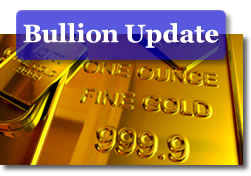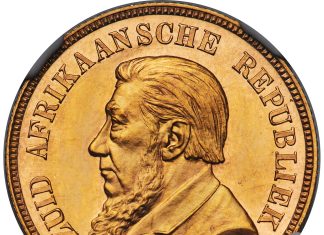 New York gold futures on Wednesday declined for a second straight day as the US dollar continued to peak at a two-month high against the yen. Other metals followed, with silver falling the quickest at 1.8 percent and under $17 an ounce. Crude oil rallied to end higher for the sixth consecutive day, nearing $80 a barrel. US stocks rose modestly to squeak out fresh 2009 highs.
New York gold futures on Wednesday declined for a second straight day as the US dollar continued to peak at a two-month high against the yen. Other metals followed, with silver falling the quickest at 1.8 percent and under $17 an ounce. Crude oil rallied to end higher for the sixth consecutive day, nearing $80 a barrel. US stocks rose modestly to squeak out fresh 2009 highs.
New York precious metal figures follow:
-
Gold for February delivery declined $5.60, or 0.5 percent, to $1,092.50 an ounce. It ranged from $1,098.70 to $1,086.60.
-
Silver for March delivery plunged another 30.8 cents to close at $16.802 an ounce. It ranged from $17.175 to $16.765.
- January platinum fell $14.80, or 1.0 percent, to end at $1,452.30 an ounce. It ranged from $1,470.60 to $1,441.70.
In PM London bullion, the benchmark gold price was fixed earlier in the day to $1,087.50 an ounce, which was a decline of $18.50 from Tuesday. Silver fell 50 cents to $16.920 an ounce. Platinum was settled at $1,461.00 an ounce, falling $11.00.
Notable bullion quotes follow:
"We would look for gold and the rest of the precious metals to track the movements of the dollar," James Moore, an analyst at TheBullionDesk.com, was quoted on MarketWatch. "Given the recovery in the dollar, we would not rule out a deeper pull-back to the $1,050 level."
"Gold prices are mirroring a rebound in the dollar with few in the market willing to trade actively," Park Jong Beom, a trader with Tongyang Futures Co. in Seoul, said on Bloomberg. "Gold will resume its feisty rally in the new year as an economic recovery reignites talk of an inflation hedge."
"Further price weakness was on tap for gold as the last full trading session got underway this morning in New York. Following yesterday’s breach of the $1100 mark, the yellow metal encountered additional waves of year-end selling and sank to lows near $1087.50 overnight," wrote Jon Nadler, senior analyst at Kitco Metals, Inc. "Dollar strength, final book-squaring, and thin participation were cited as the prime culprits in gold’s renewed descent." [Read Nadler’s full commentary.]
Gold, considered a hedge during times of high inflation and economic uncertainty, tends to follow oil and move opposite to the U.S. dollar. A rising greenback makes dollar-denominated commodities, like bullion, more expensive for holders of other world currencies.
Oil and gasoline prices
Crude oil prices climbed "to approach $80 a barrel, ending at the highest level in seven weeks after government data showed a decline in the past week’s U.S. crude inventories," wrote Moming Zhou of MarketWatch. Crude inventories declined last week by 1.5 million barrels to 326 million barrels, according to the Energy Information Administration.
"Oil is in a range right now of $68 to $80," Sean Brodrick, natural resource analyst with Weiss Research in Jupiter, Florida, said on Bloomberg. "It’s near the top of its range, and it’s a very thinly traded market because it’s a short holiday week."
New York crude-oil for February delivery rose 41 cents, or 0.5 percent, to $79.28 a barrel. It reached an intraday high of $79.80.
The national average for regular unleaded gasoline jumped 1.5 cents $2.623 a gallon, according to AAA fuel data. That is 3.9 cents higher than last week, six-tenths of a cent lower than a month back, and $1.007 more than a year ago.
U.S. Stocks
U.S. stocks rose slightly "with the Dow eking out fresh 2009 highs as investors mulled a stronger dollar and opted to play it cautious at the end of a tumultuous year," wrote Alexandra Twin of CNNMoney.
The Dow Jones industrial average gained 3.10 points, or 0.03 percent, to 10,548.51. The S&P 500 Index advanced 0.22 points, or 0.02 percent, to 1,126.42. The Nasdaq Composite Index ended up 2.88 points, or 0.13 percent, to 2,291.28.
Gold, Silver, and Metals: Prices and Commentary – Dec. 30
by Jon Nadler, Kitco Metals Inc.
Good Day,
Further price weakness was on tap for gold as the last full trading session got underway this morning in New York. Following yesterday’s breach of the $1100 mark, the yellow metal encountered additional waves of year-end selling and sank to lows near $1087.50 overnight.
Dollar strength, final book-squaring, and thin participation were cited as the prime culprits in gold’s renewed descent. Precious few bargain-hunting oriented buyers emerged in the wake of stop-losses being triggered and thus the action remained largely one-way, bringing gold values to a one-week low.
There was also a bit of forward-looking psychology at work in the market, as players were seen not welcoming the idea that US economic growth in 2010 might dent gold demand (which, as was illustrated yesterday, was quite poor during Q3 in tonnage terms) among speculative investors.
That particular species fueled gold prices for the better part of 2009, taking it to record highs, and making for the current year-end net gain tally (last seen as a positive 25% for those who held it up to now). The monthly loss in gold is now getting closer to 7% following the metal’s retreat from $1225 per ounce.
New York spot dealings opened with a $2.50 per ounce loss in gold, which was quoted at $1093.40 as against the US dollar sitting atop the 78 perch on the trade-weighted index (a gain of 0.12). By 10 am NY time, the yellow metal was off by nearly $10 and broke under the $1085 level as well. Crude oil was asleep at the wheel, losing 4 cents at $78.83 this morning.
Silver broke under the $17 level, dropping 26 cents in early trade. Platinum initially gained $1 to $1464 but quickly fell $11 to $1464 as profit-takers raided the pits in that metal as well this morning. Palladium, by contrast, opened with a $6 gain and rose an additional $1 later on, to $391 per ounce. No change was reported in rhodium – steady at $2340 per ounce.
Two notable market commentators summed up this late 2009 situation as follows, when queried by Bloomberg: "Gold may fall to $900 before investors and the public at large try to buy and hold the market," said Bernard Sin, head of currency and metals trading at bullion-refiner MKS Finance SA in Geneva. "I am dollar bullish because I believe the U.S. economy can grow." MKS is a world-renowned refiner and fabricator of investment products in the precious metal.
"The 20-day moving average for spot gold at about $1,120 an ounce is "perilously close" to the 50-day moving average of about $1,118 an ounce, according to Rhona O’Connell, managing director of research company GFMS Analytics Ltd. in London. A drop in the 20-day price to below the 50-day price "would not be good news at all" for investors betting on higher prices, she said. "Technicals look horrid."
Recycling Today has posted a very interesting piece on scrap flows in the precious metals markets. For today’s closing section, we bring you highlights from their study:
"Tough times run up precious metals prices and bring materials out of nooks and crannies. The current crunch is no exception. The housing market is dead. The dollar is weaker than any time in recent memory. Business is slow almost everywhere. As a result, prices of gold, silver and PGMs (platinum group metals) are up. For recyclers who make a living on the spread between their buy and sell prices, things are fairly comfortable right now.
Materials are flowing. Even the PGM area, where dismal car sales generally mean fewer vehicles scrapped, has a bright lining in the form of Cash for Clunkers. With an increase of palladium scrap from Europe, especially in the second half of 2009, recycled palladium could see increases of some 13 percent back to near 2008 levels of 1.1 million ounces. Platinum could post more modest gains in 2010 over last year, perhaps up 10 percent to 820,000 ounces, while rhodium could rise to 195,000 ounces, or 11 percent," Kumar says.
Platinum supplies are forecast to climb by 110,000 ounces to just above 6 million ounces. That 2 percent increase comes in the face of soft demand. This is despite a decline in basic mine production. About 655,000 extra ounces of palladium were on the market as 2009 closed, despite a drop in supplies of 1.8 percent to 7.2 million ounces. Again, less demand for catalysts is depressing consumption as is the fall in industrial and chemical industry demand. Catalyst demand ended 2009 off by about 12.7 percent at 3.9 million ounces. The low price of palladium–in the $300- to $400-per-ounce range–will boost demand.
"Investment demand still appears to be the price driver in the metals markets," Kumar says. For platinum, exchange-traded-fund (ETF) holdings of physical metal have risen to a total of more than 600,000 ounces as of the end of October. "The amount of physical platinum held in London vaults to back investor purchases of ETF securities has doubled since the start of January 2009, when stocks totaled only 307,930 ounces," he says. Additionally, speculative positions for platinum on New York Mercantile Exchange (NYMEX) and Tokyo Commodity Exchange (TOCOM) now total 1.5 million ounces.
"2010 will bring some recovery in automotive and industrial demand for platinum," Johnson Matthey says. "Supplies are not likely to grow to the same extent and the market could move into a modest deficit." This would be good news for platinum prices. Johnson Matthey projects platinum will trade between $1,280 and $1,550 per ounce during the first half of 2010.
"It is easy to argue that platinum may be set for a correction, given that the price has risen $250 an ounce, or more than 20 percent, in the past quarter alone," Kumar says. "But with speculative investors seemingly intent on raising gold above the $1,200 mark, platinum could certainly breach $1,500 an ounce in the short term." However, he says any short-term strengthening of the dollar, particularly in reaction to talk of a reversal in current liquidity policies, could adversely affect commodities, and platinum at some point could re-trace its recent gains back to test support at $1,350 or even overshoot down to $1,250 per ounce, before resuming its longer-term upward trend.
Palladium should trade between $290 and $390, according to Johnson Matthey economists. With mine production soft, sale of the rest of Russia’s state stocks and demand in Europe for better pollution controls on diesel engines, the price could be at the upper end of that range by June. A strong dollar or a serious drop in gold and platinum would push the trading range down to the low $300s or less. Kumar cautions that, should palladium sustain its recent move above the $375 level and continue to firm toward $400, significant additional supply of the metal could come to market, which could dampen further price increases."
Have a nice Wednesday.
Jon Nadler
Senior Analyst
Kitco Metals Inc.
North America
Blog: http://www.kitco.com/ind/index.html#nadler
In related US Mint silver coin news of the day, read US Mint 2009 Silver Eagles Peak.










